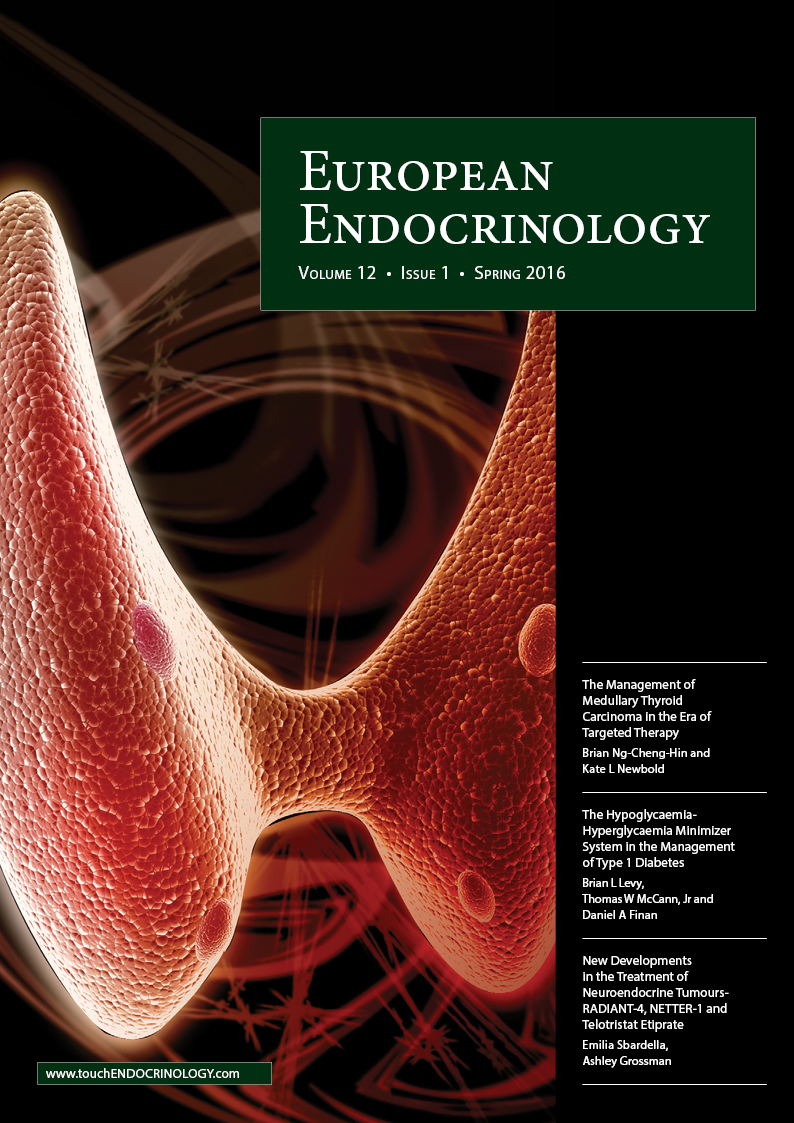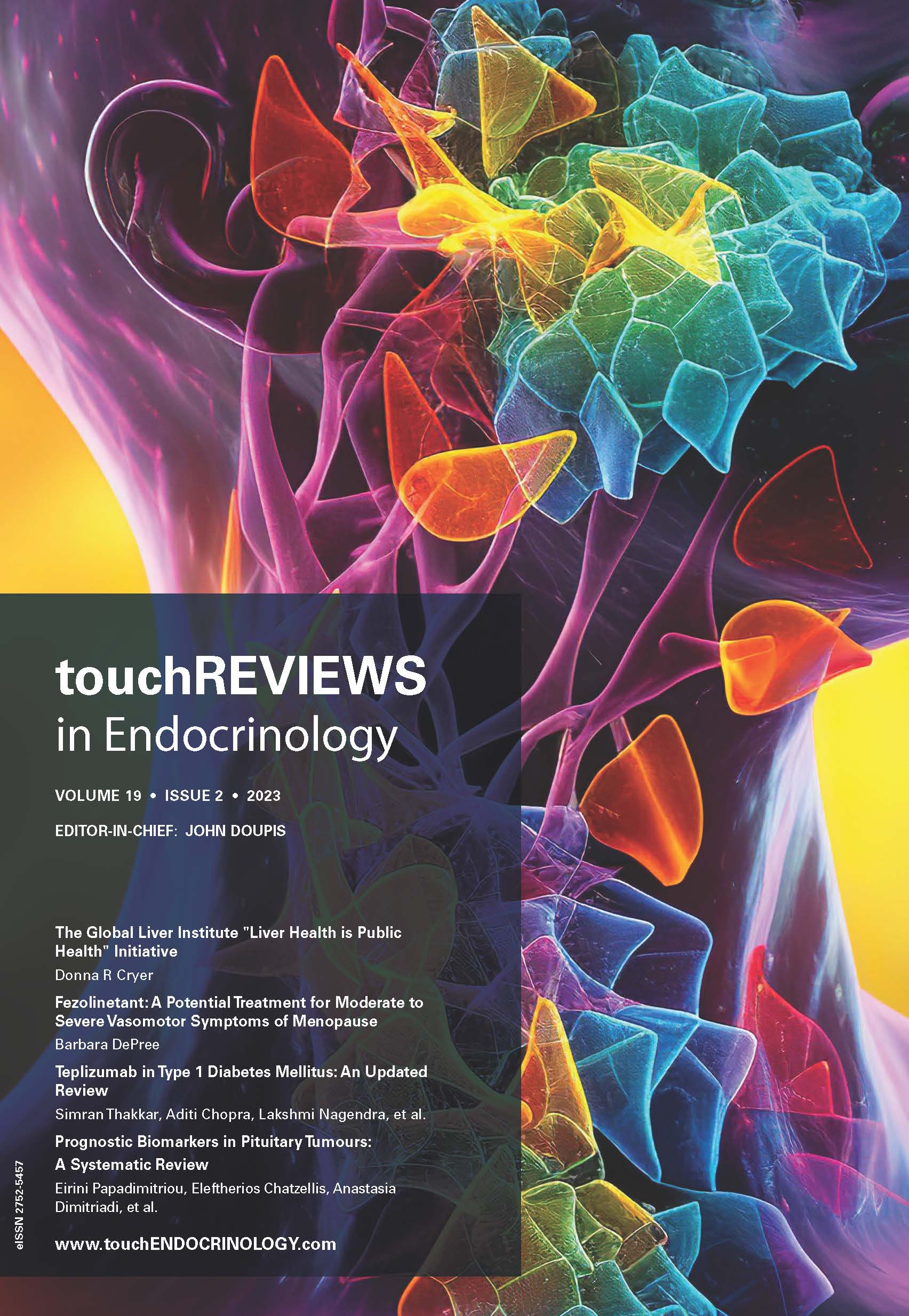EUROPEAN ENDOCRINOLOGY – VOLUME 12 ISSUE 1 – SPRING 2016
We are very pleased to present the spring edition of European Endocrinology. This edition, expertly introduced by Editorial Board member Chantal Mathieu, features timely review articles and topical editorials, written by esteemed experts, succinctly examining a wide range of important topics including diabetes, thyroid cancer, neuroendocrine tumours, plus many more.
We hope you find this issue useful and that it provides helpful information and discussions that are relevant to your practice and interests. Please peruse and enjoy the expert content and we welcome any feedback you may have.
Foreword
Welcome to the latest edition of European Endocrinology, which features a wide range of topical articles covering various areas of endocrinology. We begin with a focus on diabetes. Insulin therapy remains the standard of care in type 1 and advanced type 2 diabetes, and the development of recombinant human insulins has increased the global availability […]
Diabetes
Insulin preparations extracted from bovine or porcine pancreatic tissue have served as the mainstay of diabetes therapy since 1923, when commercial production was established in Europe and the US.1 Animal insulin sources became a limiting factor to provide sufficient supply of insulin for the increasing clinical demand of insulin worldwide. When the molecular structure of […]
Type 1 diabetes (T1D) is a lifelong condition that results from autoimmune destruction of insulin-secreting beta cells, resulting in an absence of insulin production. In the US, it is estimated that 29.1 million people have diabetes,1 with T1D accounting for 5–10% of all cases. Furthermore, its incidence is increasing, particularly among children under the age […]
Type 1 diabetes (T1D) and advanced type 2 diabetes (T2D) require intensive insulin therapy in combination with frequent glucose monitoring to optimise glycaemic control. Although the value of achieving normoglycaemia has been well demonstrated,1 many individuals with insulin-treated diabetes are unable to meet established glycaemic targets without excessive and/or severe hypoglycaemia.2–5 The introduction of self-monitoring […]
Type 2 diabetes is a progressive chronic disease leading to vascular complications over the years when treated insufficiently.1,2 Treatment consists of a lifestyle intervention aimed at improving physical activity and healthy nutrition, later followed by oral antidiabetic drugs and injectable medications (glucagon-like peptide [GLP]-1 receptor agonists or insulin).3,4 Novel antidiabetic agents have had to prove […]
Sodium-glucose cotransporter 2 inhibitors (SGLT2i) are the latest class of oral glucose-lowering agents proposed for the treatment of patients with type 2 diabetes mellitus (DM2). Besides lowering blood glucose in an insulin-independent manner by blocking the tubular reabsorption of filtered glucose, they also have a positive effect on blood pressure, weight control and albuminuria, making […]
The recent Advanced Therapeutics and Technologies in Diabetes (ATTD) conference held in Milan, Italy was a timely reminder of how the mechanics and engineering precision involved in diabetes technologies can sometimes seem to be on the polar opposite end of the spectrum from the psychosocial aspects of these technologies. A review of the latest devices, […]
Obesity and Weight Management
Laparoscopic sleeve gastrectomy was initially described as a stage procedure for high-risk patients, followed six months later with either a full duodenal switch or gastric bypass.1 Laparoscopic sleeve gastrectomy is now the dominant weight-loss surgery in the US, an achievement that was never attained with the less invasive adjustable gastric banding. American patients are choosing […]
Thyroid Disorders
Medullary Thyroid Cancer (MTC) is a rare cancer of the thyroid parafollicular or ‘C’ cells, and is estimated to make up around 5–10% of all thyroid cancers.1 MTC was first described in 1906 by Jacquet as a thyroid tumour with amyloid, but the term MTC and its histological description of a solid non-follicular tumour with […]
Neuroendocrine Tumours
Neuroendocrine tumours (NETs) represent a heterogeneous group of neoplasms that originate from different types of neuroendocrine cells throughout the body.1 While previously considered to be relatively uncommon, their overall incidence has been reported as increasing for reasons which are unclear.2–4 Surgery is the only truly curative therapy, but there are now a variety of other […]
Hypoparathyroidism
Hypoparathyroidism is a rare disease, characterised by low or undetectable serum parathyroid hormone (PTH), hypocalcemia, hyperphosphatemia and, frequently, hypomagnesaemia. Symptoms include neuromuscular irritability causing tetany, muscle cramping and seizures. In adults, the disorder is usually a complication of neck surgery. In children, the condition is most often due to inherited disorders such as autoimmune polyglandular […]
US Endocrinology Highlights
Diabetes mellitus (DM) is a global epidemic.1 In 2013, there were 382 million people with DM, and this number is expected to rise to 592 million by 2035.2 Type 1 diabetes (T1DM), which is caused mainly by an autoimmunemediated destruction of beta cells within the islet of Langerhans, accounts for 5–10 % of the total […]
The autoimmune thyroid diseases (AITD) comprise a series of interrelated conditions including Graves’ disease (GD) and Hashimoto’s thyroiditis (HT). AITD are the most prevalent diseases of the thyroid gland in the pediatric population, particularly in adolescence.1 HT is the leading cause of goiter and hypothyroidism in children and adolescents in countries with adequate iodine supplementation.2–3 […]
In 1932, Dr Harvey Cushing published his findings on a series of patients with what he called the “killing disease,” revealing that the median survival for most of his patients was less than 5 years from diagnosis.1 With advances in surgical techniques and medical management of comorbidities, the standardized mortality ratio for patients with Cushing’s […]

Trending Topic
Welcome to the latest edition of touchREVIEWS in Endocrinology, which features a range of review, case report and original research articles that highlight some key developments in our understanding and management of endocrinological disease. We begin with a commentary from Eleni Armeni and Ashley Grossman on seliciclib, a potential new treatment for patients with Cushing’s […]
Journal Archive
touchREVIEWS in Endocrinology (previously European Endocrinology) is a peer-reviewed, free-to-access, bi-annual journal comprising review articles, case reports, editorials, special reports and original research. It features balanced and comprehensive articles written by leading authorities, addressing the most important and salient developments in the field of endocrinology.
Latest articles videos and clinical updates - straight to your inbox
Log into your Touch Account
Earn and track your CME credits on the go, save articles for later, and follow the latest congress coverage.
Register now for FREE Access
Register for free to hear about the latest expert-led education, peer-reviewed articles, conference highlights, and innovative CME activities.
Sign up with an Email
Or use a Social Account.
This Functionality is for
Members Only
Explore the latest in medical education and stay current in your field. Create a free account to track your learning.



















